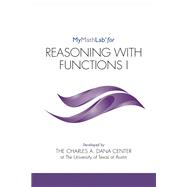NOTE: Before purchasing, check with your instructor to ensure you select the correct ISBN. Several versions of Pearson's MyLab & Mastering products exist for each title, and registrations are not transferable. To register for and use Pearson's MyLab & Mastering products, you may also need a Course ID, which your instructor will provide.
Used books, rentals, and purchases made outside of Pearson
If purchasing or renting from companies other than Pearson, the access codes for Pearson's MyLab & Mastering products may not be included, may be incorrect, or may be previously redeemed. Check with the seller before completing your purchase.
This course is a credit-bearing course in Precalculus Math
MyMathLab for Reasoning with Functions I is part of a series of MyMathLab courses built to support the New Mathways Project developed by the Charles A. Dana Center. The New Mathways Project embodies the Dana Center’s vision for a systemic approach to improving student success and completion through implementation of processes, strategies, and structures built around three mathematics pathways.
Reasoning with Functions I is the first of two college-level courses designed to prepare students to enter calculus and succeed in STEM coursework that requires a thorough knowledge of functions and algebraic reasoning. Students build a strong foundation in functions and their behavior by using multiple representations and explicit covariational reasoning to investigate and explore quantities, their relationships, and how these relationships change. It is designed as a five-contact-hour course, with the Intermediate and College Algebra skills needed to prepare for Reasoning with Functions II. The MyMathLab course designed for use with Reasoning with Functions I provides:
- Interactive content to help prepare students for active classroom time
- In-Class Interactive Lessons to support students through an active classroom experience, accompanied by notebook PDFs
- Homework assignments designed to assess conceptual understanding of important skills and concepts
- Additional resources for instructors to help facilitate an interactive and engaging classroom
Built in MyMathLab
Content developed by the Charles A. Dana Center at The University of Texas at Austin will be delivered through MyMathLab. MyMathLab is an online homework, tutorial, and assessment program that engages students and improves results. Within its structured environment, students practice what they learn, test their understanding, and pursue a personalized study plan that helps them absorb course material and understand difficult concepts.








